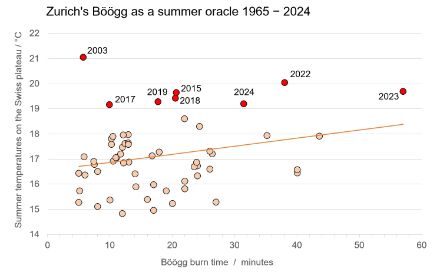Service Navigation
Search
The highlight of the Sechseläuten, the traditional spring festival of the Zurich guilds, is the burning of the Böögg. The effigy, made of cotton wool, is set alight on a large pyre in the Sechseläutenplatz at six in the evening, on the sixth stroke of the bells of St Peter's Church. The time it takes for the Böögg to lose his firework-filled head is supposed to be a predictor of the coming summer weather. When the suffering is short-lived, this supposedly augurs well for a beautiful summer – a prediction which can be checked against meteorological data.
Böögg burn time and summer temperatures
To put the summer weather prognosis to the test, we need to compare an appropriate index over time. Average summer temperature serves the purpose here. The graph below shows the average summer temperature and the burn time of the Böögg plotted as points for each year.

The statistical analysis shows no significant correlation between the burn time of the Böögg and the summer temperatures in the Swiss Plateau. Or, to put it another way: There is no evidence to support the supposed predictive nature of the Böögg.
Hot summer of 2003 "predicted"
It is noteworthy that, ahead of the hot summer of 2003, the Böögg had exploded after only 5 minutes and 42 seconds. However, this was obviously pure coincidence. Before the second hottest summer of 2022, the Böögg only exploded after almost 40 minutes. Before the third and fourth hottest summers of 2018 and 2015, the burn time was between 20 and 21 minutes. In these three years, the Böögg was a poor forecaster. Even in 2019, with the fifth hottest summer on record, it did not provide an accurate forecast, burning for just under 18 minutes.
The Böögg is no weatherman
It is not surprising that the Böögg scores so poorly as a forecaster in this study. How is a burning snowman made of cotton wool supposed to have good predictive qualities? In reality, the burn time depends on the construction of the pyre, the humidity of the firewood and the weather on the day of the Sechseläuten. Last but not least, there is the all-important factor of how much fire accelerant is used. Nevertheless, although the Böögg's summer forecast cannot be scientifically supported, Zurich would certainly not be without its oracle.
Seasonal climate forecasts from MeteoSwiss
The seasonal forecast from MeteoSwiss provides somewhat more certainty about the coming summer. With the help of a numerical model, the climate can be forecast several months in advance.
With this forecast, when we compare the mean summer temperatures with the actual measured values, we do indeed see a statistically significant correlation. So the model is better than simple guesswork, even though there are false predictions every now and then. The climate outlook for the summer is available at the end of May each year.